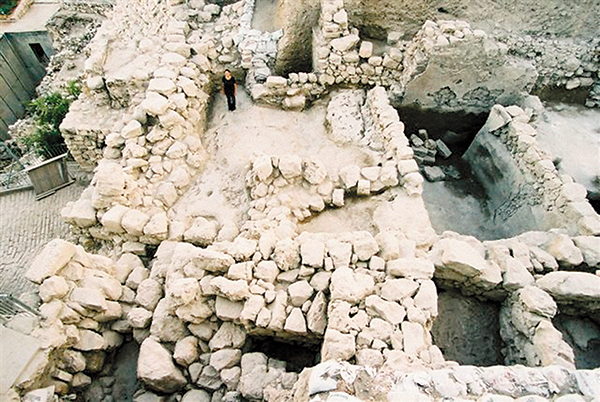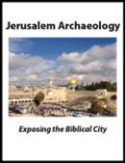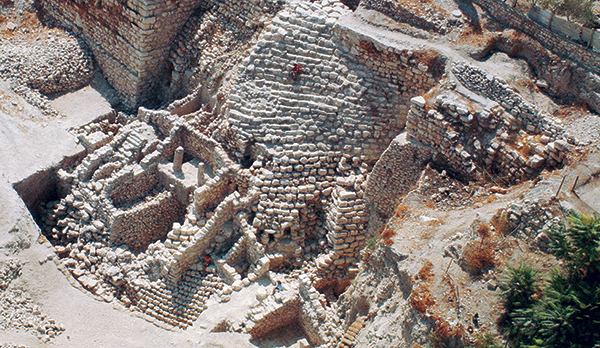In the field of biblical archaeology, biblical texts and archaeological finds must be examined critically and independently, but ultimately, they must be interpreted together. Such an approach can be applied to King David’s Palace and the Millo, as explored in “The Interchange Between Bible and Archaeology: The Case of David’s Palace and the Millo” by Nadav Na’aman in the January/February 2014 issue of BAR.
Two major monuments lie south of the Temple Mount in the City of David: the Large Stone Structure and Stepped Stone Structure. Building on previous suggestions, Nadav Na’aman uses textual and archaeological evidence to identify these monuments as, respectively, the remains of King David’s palace and the Millo.

The Large Stone Structure is identified as King David’s Palace by its excavator, Eilat Mazar, as well as by author Nadav Na’aman. Photo: Eilat Mazar.
The Large Stone Structure, located on a rocky spur in the City of David, is a large public building comprised of impressive ashlar blocks. Its excavator, Eilat Mazar, dated the building to the 11th–10th centuries B.C.E. That King David’s palace is prominent and prominently located is referenced in the Book of Samuel (2 Samuel 5:11; 2 Samuel 11; 2 Samuel 16:22). When Nehemiah returned from Babylonian exile half a millennium after the reign of David, he repaired the city wall and organized a dedication procession. One group on the east side of the city was described as having gone “up the steps of the City of David, on the ascent to the wall, past the House of David, and up to the Water Gate on the east” (Nehemiah 12:37). Nadav Na’aman suggests that King David’s Palace must be found at the top of the city’s northeastern slope, just above the Stepped Stone Structure that would have provided an ascent to the summit on the east. The location, date and scale of the Large Stone Structure, Nadav Na’aman believes, matches the biblical descriptions of King David’s Palace.

After David conquered the Jebusite “stronghold of Zion,” he is said to have renamed the area the City of David and fortified it “from the Millo inward” (2 Samuel 5:7–9). The etymology of the Hebrew word “millo” may be derived from the verb ml’, to “fill up.” Nadav Na’aman suggests that the Stepped Stone Structure, which extends down the slope from the Large Stone Structure and is built of a fill of stones and earth, may be the Millo referenced in the Book of Samuel.

The Stepped Stone Structure sits on the eastern slope of the City of David. Could it be the Millo referenced in the Bible? Nadav Na’aman believes so. Photo: Zev Radovan.
Two bullae, or seal impressions, of Judahite officials were found in excavations near the Large Stone Structure. One bulla bears the name Gedaliah son of Pashhur, the other the name Jehucal son of Shelemiah son of Shobai. These two men are mentioned together as officials of King Zedekiah in the Bible (Jeremiah 37:3, 38:1). The discovery of these bullae near the Large Stone Structure suggests to Nadav Na’aman that this is where the two officials officiated and that this building was still in use in the early sixth century B.C.E.
The combination of biblical and archaeological evidence offers intriguing—though still tentative—support for the identification of King David’s Palace and the Millo on the northeastern crest of the City of David.
This Bible History Daily feature was originally published on January 17, 2014.
Related reading in Bible History Daily:
Did I Find King David’s Palace? by Eilat Mazar
The Tel Dan Inscription: The First Historical Evidence of King David from the Bible
Get more biblical Archaeology: Become a Member
The world of the Bible is knowable. We can learn about the society where the ancient Israelites, and later Jesus and the Apostles, lived through the modern discoveries that provide us clues.
Biblical Archaeology Review is the guide on that fascinating journey. Here is your ticket to join us as we discover more and more about the biblical world and its people.
Each issue of Biblical Archaeology Review features lavishly illustrated and easy-to-understand articles such as:
• Fascinating finds from the Hebrew Bible and New Testament periods
• The latest scholarship by the world's greatest archaeologists and distinguished scholars
• Stunning color photographs, informative maps, and diagrams
• BAR's unique departments
• Reviews of the latest books on biblical archaeology
The BAS Digital Library includes:
• 45+ years of Biblical Archaeology Review
• 20+ years of Bible Review online, providing critical interpretations of biblical texts
• 8 years of Archaeology Odyssey online, exploring the ancient roots of the Western world in a scholarly and entertaining way,
• The New Encyclopedia of Archaeological Excavations in the Holy Land
• Video lectures from world-renowned experts.
• Access to 50+ curated Special Collections,
• Four highly acclaimed books, published in conjunction with the Smithsonian Institution: Aspects of Monotheism, Feminist Approaches to the Bible, The Rise of Ancient Israel and The Search for Jesus.
The All-Access membership pass is the way to get to know the Bible through biblical archaeology.
The post King David’s Palace and the Millo appeared first on Biblical Archaeology Society.


0 Commentaires